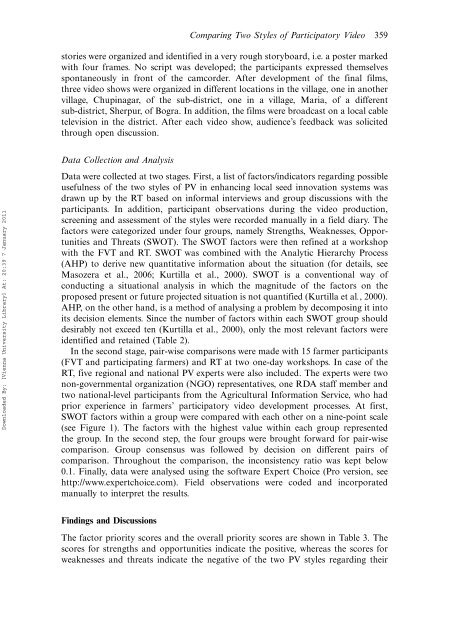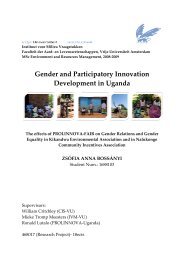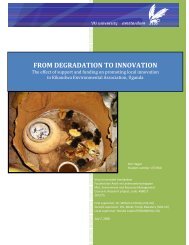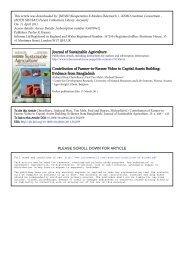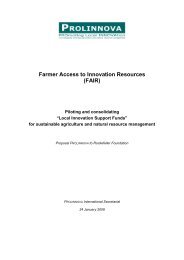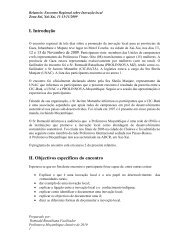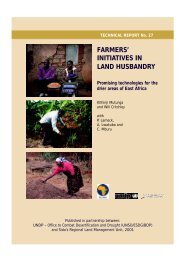Chowdhury et al (2010); PDF file - Prolinnova
Chowdhury et al (2010); PDF file - Prolinnova
Chowdhury et al (2010); PDF file - Prolinnova
Create successful ePaper yourself
Turn your PDF publications into a flip-book with our unique Google optimized e-Paper software.
Comparing Two Styles of Participatory Video 359<br />
stories were organized and identified in a very rough storyboard, i.e. a poster marked<br />
with four frames. No script was developed; the participants expressed themselves<br />
spontaneously in front of the camcorder. After development of the fin<strong>al</strong> films,<br />
three video shows were organized in different locations in the village, one in another<br />
village, Chupinagar, of the sub-district, one in a village, Maria, of a different<br />
sub-district, Sherpur, of Bogra. In addition, the films were broadcast on a loc<strong>al</strong> cable<br />
television in the district. After each video show, audience’s feedback was solicited<br />
through open discussion.<br />
Downloaded By: [Vienna University Library] At: 20:39 7 January 2011<br />
Data Collection and An<strong>al</strong>ysis<br />
Data were collected at two stages. First, a list of factors/indicators regarding possible<br />
usefulness of the two styles of PV in enhancing loc<strong>al</strong> seed innovation systems was<br />
drawn up by the RT based on inform<strong>al</strong> interviews and group discussions with the<br />
participants. In addition, participant observations during the video production,<br />
screening and assessment of the styles were recorded manu<strong>al</strong>ly in a field diary. The<br />
factors were categorized under four groups, namely Strengths, Weaknesses, Opportunities<br />
and Threats (SWOT). The SWOT factors were then refined at a workshop<br />
with the FVT and RT. SWOT was combined with the An<strong>al</strong>ytic Hierarchy Process<br />
(AHP) to derive new quantitative information about the situation (for d<strong>et</strong>ails, see<br />
Masozera <strong>et</strong> <strong>al</strong>., 2006; Kurtilla <strong>et</strong> <strong>al</strong>., 2000). SWOT is a convention<strong>al</strong> way of<br />
conducting a situation<strong>al</strong> an<strong>al</strong>ysis in which the magnitude of the factors on the<br />
proposed present or future projected situation is not quantified (Kurtilla <strong>et</strong> <strong>al</strong>., 2000).<br />
AHP, on the other hand, is a m<strong>et</strong>hod of an<strong>al</strong>ysing a problem by decomposing it into<br />
its decision elements. Since the number of factors within each SWOT group should<br />
desirably not exceed ten (Kurtilla <strong>et</strong> <strong>al</strong>., 2000), only the most relevant factors were<br />
identified and r<strong>et</strong>ained (Table 2).<br />
In the second stage, pair-wise comparisons were made with 15 farmer participants<br />
(FVT and participating farmers) and RT at two one-day workshops. In case of the<br />
RT, five region<strong>al</strong> and nation<strong>al</strong> PV experts were <strong>al</strong>so included. The experts were two<br />
non-government<strong>al</strong> organization (NGO) representatives, one RDA staff member and<br />
two nation<strong>al</strong>-level participants from the Agricultur<strong>al</strong> Information Service, who had<br />
prior experience in farmers’ participatory video development processes. At first,<br />
SWOT factors within a group were compared with each other on a nine-point sc<strong>al</strong>e<br />
(see Figure 1). The factors with the highest v<strong>al</strong>ue within each group represented<br />
the group. In the second step, the four groups were brought forward for pair-wise<br />
comparison. Group consensus was followed by decision on different pairs of<br />
comparison. Throughout the comparison, the inconsistency ratio was kept below<br />
0.1. Fin<strong>al</strong>ly, data were an<strong>al</strong>ysed using the software Expert Choice (Pro version, see<br />
http://www.expertchoice.com). Field observations were coded and incorporated<br />
manu<strong>al</strong>ly to interpr<strong>et</strong> the results.<br />
Findings and Discussions<br />
The factor priority scores and the over<strong>al</strong>l priority scores are shown in Table 3. The<br />
scores for strengths and opportunities indicate the positive, whereas the scores for<br />
weaknesses and threats indicate the negative of the two PV styles regarding their


